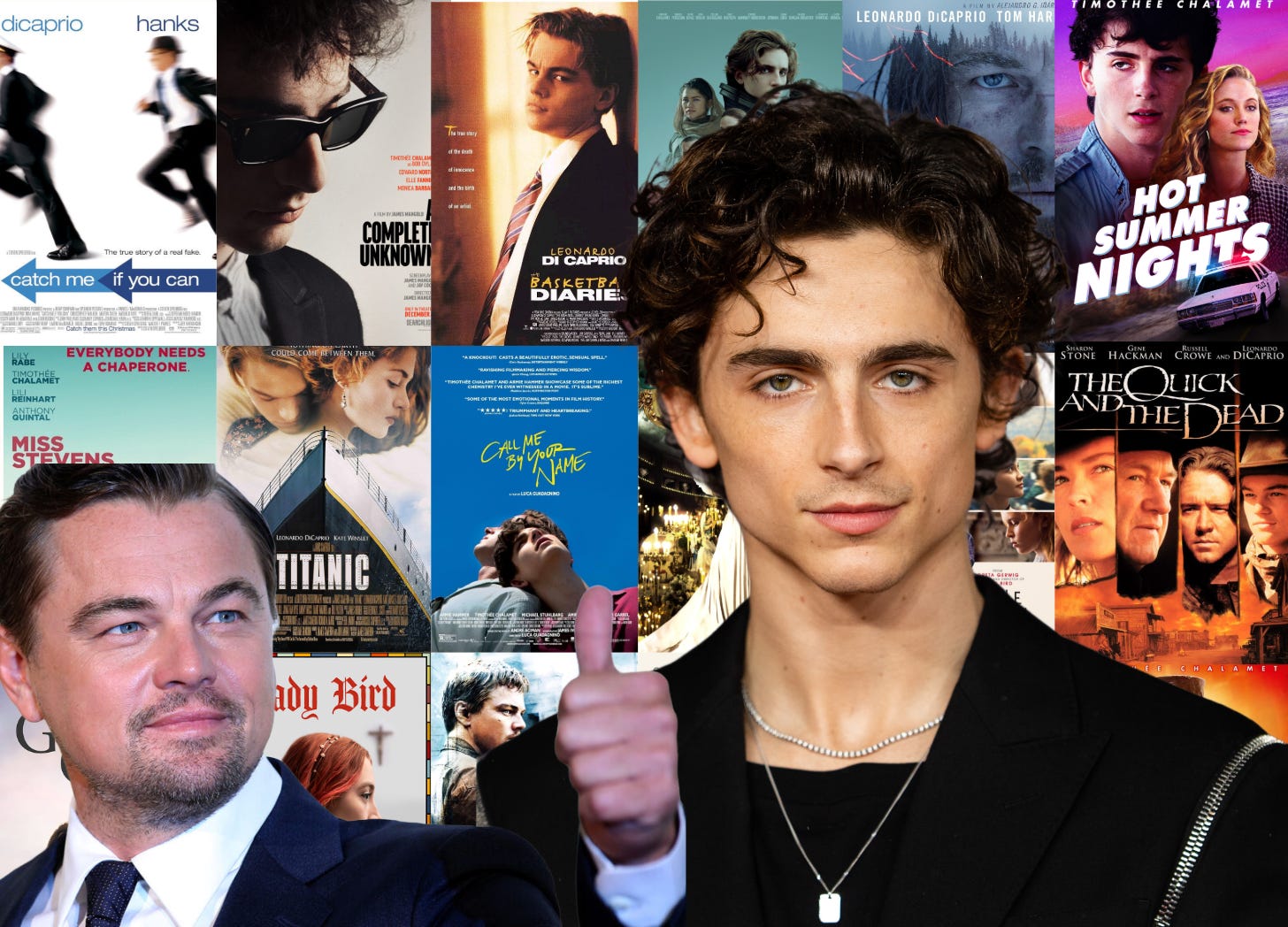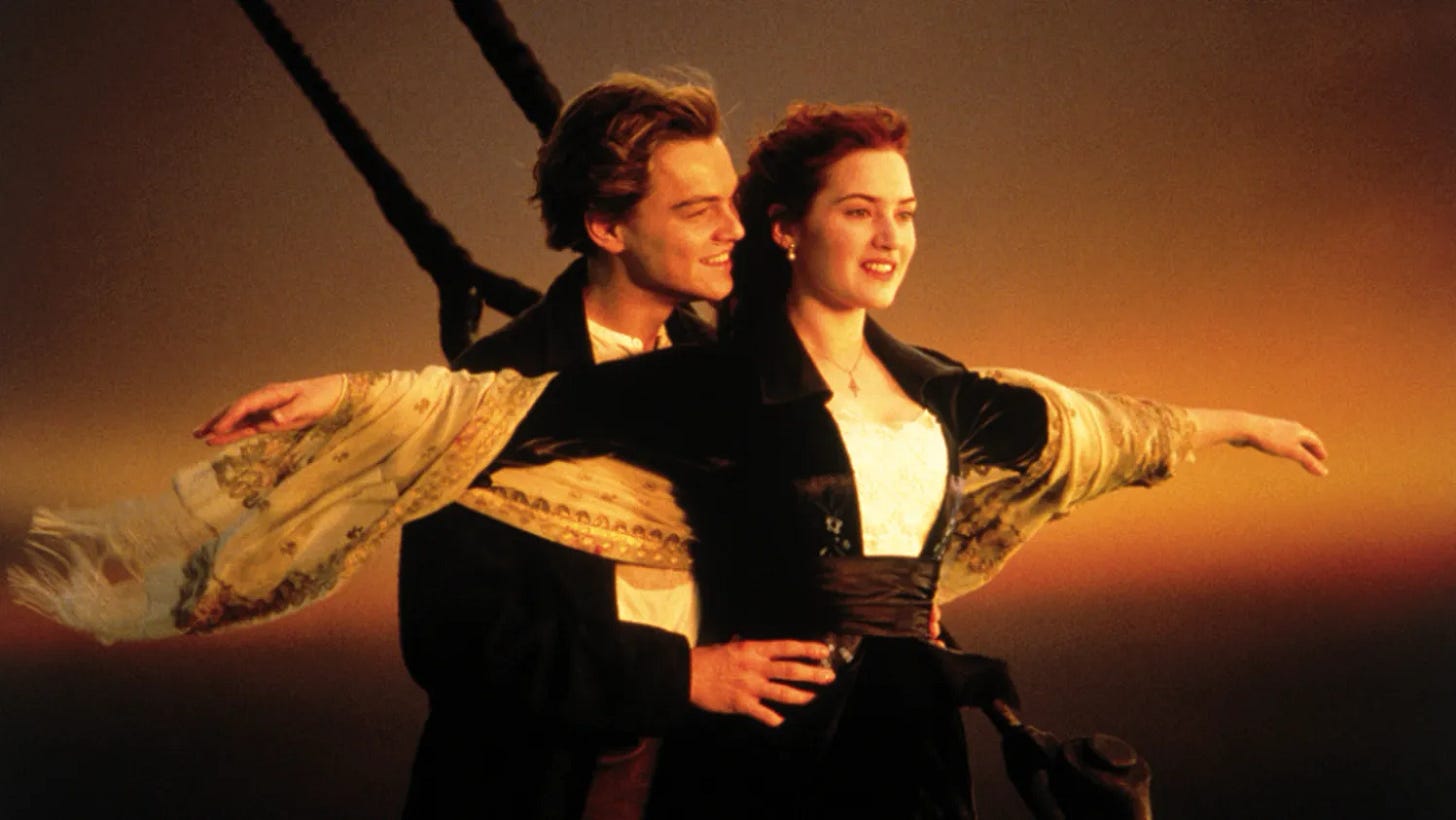Tracking Timothée Chalamet on the DiCaprio Career Trajectory Scale (DCTS)
An important update from the scientific community
The DiCaprio Career Trajectory Scale (DCTS) is the official tool1 scientists use to establish how close the career of an actor is mapping onto the illustrious career of Leonardo DiCaprio. With an ongoing oeuvre that has paved a unique path for the actor through Hollywood since the early 90s, DiCaprio’s exact brand of films and critical reception have been difficult to duplicate amidst a world of social media, streaming, and Marvel domination. However, with the release of A Complete Unknown (James Mangold, 2024), the scientific community is ready to announce that Timothée Chalamet has progressed through to a key stage of the DCTS that could prove the scale can be replicated.
The Key Steps on the DCTS
The DCTS has three key steps, marking major stages in the evolution of DiCaprio’s career. These steps not only reflect film types but also external critical reception of the actor and placement in pop culture.
Step 1: Early Romance and Indie Movies
The actor breaks out at a young age (often following television and small film roles as a child actor), starring mostly in independent films and romances. While many actors start this way, there is a level of distinction to many of these early films in the DCTS that makes it more than just a generic grind to popularity. Often working with acclaimed directors and established stars, their talent and audience-drawing potential will soon be recognised. This step is accompanied by a very youthful look and strong twink energy appreciated largely by women and queer fans (A.K.A ‘the gals and the gays’).
While the actor may go on to win great acclaim in future film performances, many may argue that this era contained their strongest, most grounded roles.
For DiCaprio, this step covers 1993-1996. Films within this era include The Basketball Diaries (Scott Kalvert, 1995), What’s Eating Gilbert Grape (Lasse Hallström, 1993), Romeo + Juliet (Baz Luhrmann, 1996), and The Quick and the Dead (Sam Raimi, 1995).
Step 2: The Blockbuster
The actor will make a huge leap forward and star in a blockbuster film. However, this blockbuster cannot be a superhero movie. This is where many other actors fall off the scale. DiCaprio has maintained his strong career without the superhero film boost. While, depending on the quality of the film, it may be acceptable to dabble in this later in a career2, this first major blockbuster on the DCTS must be outside that genre.
Significantly, this blockbuster must be accompanied by large financial and critical success that then gives the actor the ability to gain greater control over their career. This will foster a safe transition into step 3.
This moment for DiCaprio comes in 1997 with the release of Titanic (James Cameron, 1997).
Step 3: The Oscar Bait
While some indie films may still follow over the next couple of years after the blockbuster, within five years the actor will firmly settle into this third phase of the scale. This step covers the majority of the DCTS, as the scale requires a rapid rise to fame that allows more autonomous choice over projects very early on. Once at this stage, an actor's career will be almost entirely prestige films of Oscar calibre, as since 2002 DiCaprio has only been in three films that weren’t nominated for Academy Awards3. While it took a long time for DiCaprio to achieve an Oscar win in this step, an early career Oscar doesn’t discount an actor from continuing to follow this path. It’s not so much about the awards won by the individual, but the awards their films attract.
For DiCaprio, this era firmly begins in 2002 and continues on to the present day.
The Biopic Shift
There is a key internal moment within the DCTS, most likely experienced early in step 3. This is when an actor takes on a biopic that marks the end of their boyish good looks and transitions them out of their twink era. This moment for DiCaprio was Catch Me If You Can (Steven Spielberg, 2002), the film featuring the last vestige of his 90s charms. The Aviator (Martin Scorsese, 2004)4 saw this shift even more before the transition became complete in The Departed (Martin Scorsese, 2006). Science has confirmed that this was not down to witchcraft, but the human process of ageing merely captured on screen.
Chalamet and the DCTS
Chalamet has effectively been speedrunning the DCTS since 2016. His early romance and indie phase mirrored some elements of DiCaprio’s 90s career exactly, covering a heroin-addicted teen movie (his Beautiful Boy to DiCaprio’s The Basketball Diaries), a romantic lead in a strongly directed piece (his Call Me by Your Name to DiCaprio’s Romeo + Juliet) and an adaptation of a male-dominated period epic (his The King to DiCaprio’s The Man in the Iron Mask).
Chalamet then entered Step 2 with Dune Part One (Denis Villeneuve, 2021), leaping over the non-superhero blockbuster hurdle that is the stumbling block for many others5.
Now, after much consultation and debate, the scientific community has confirmed that Timothée Chalamet has entered into Step 3 of the DCTS with the release of A Complete Unknown. They have also concluded that this film enters him into the biopic shift. It is likely this will be a goodbye to the youthful Timmy, with his upcoming Marty Supreme (Josh Safdie, TBD) further transitioning him out of his youthful charms.
The internet has been quick to identify this shift, with many members of subreddits lamenting a change in his facial features. Scientists have analysed these changes thoroughly, and while there was some interest in claims that something mysterious had happened, they did in fact determine this to be the aforementioned, well-established process known as ageing that we have come to learn celebrities do in fact experience (though this is still largely unaccepted in mainstream circles). They also suspect some of the shift in his demeanour and expression could be due to the existential disorientation one might experience when subreddits of people who have never met you obsess about your life decisions and appearance.
Next Steps
With DiCaprio still an active actor, it remains to be seen if further steps on the DCTS will emerge in the latter part of his career and whether Chalamet will continue to follow his path. If he keeps along this trajectory, we can expect fewer films from Chalamet, but each one will be a major event. This may be the end of Chalamet as a pure romantic lead, as unfortunately that genre of film tends to be ignored as a serious pursuit (which is sick and wrong). Though a depressing, romantic drama could still be in the realm of possibility, as DiCaprio’s Revolutionary Road (Sam Mendes, 2008) came during this step 3 era. DiCaprio’s step 3 has also been accompanied by a close filmmaking relationship with Martin Scorsese, who has directed 38% of the feature films DiCaprio has starred in since 2002. It will be interesting to see if Chalamet develops any similar directorial bonds.
Scientists will continue to observe this phenomenon as well as keep an eye on future rising stars that may also find themselves on the DCTS.
Scientists would also like to make it clear that this isn’t some weird parasocial exercise designed to examine the personal lives of celebrities (because nothing we know about them is real, and encouragement of such pursuits is part of a harmful publicity machine designed to manipulate our feelings and commodify human beings). It’s just like a fun thing they noticed about the kinds of movies these dudes do, alright?
Let’s do this together
I would love to get your comments and insights on my work so we can grow this place together. Please like and share and comment and all that other stuff. It’s much appreciated.
By which I mean completely made up by me
This is a point of debate amongst scientists of the field. Some would discredit any superhero film, while others would give a pass as long as it was outside of the Marvel cannon.
J Edgar (Clint Eastwood, 2011), Shutter Island (Martin Scorcese, 2010) and Body of Lies (Ridley Scott, 2008)
You can see the shift happen in real time during The Aviator in the stark difference between young and old Howard Hughes DiCaprio portrays.













I loved DiCaprio until his jawline changed…looks like I’m going the same way with Chalamet. Thanks for backing this up with science!